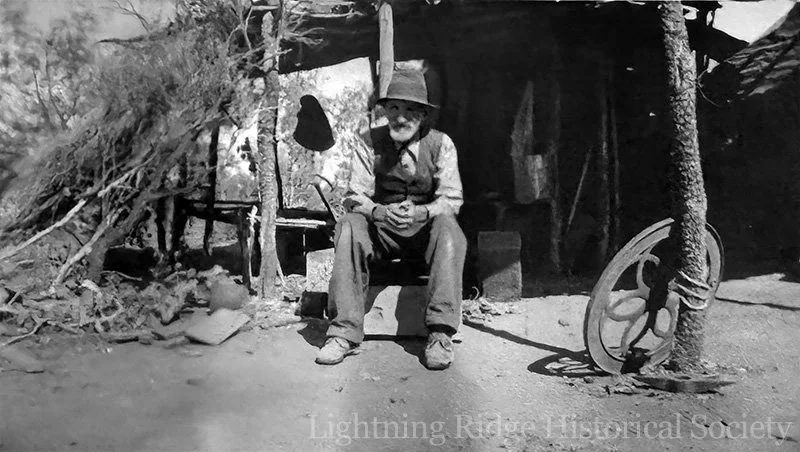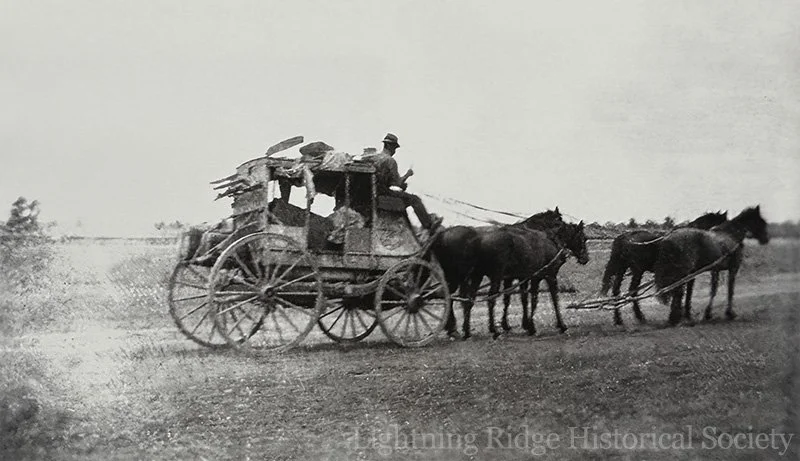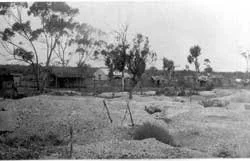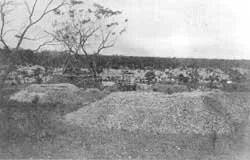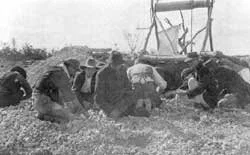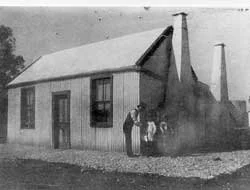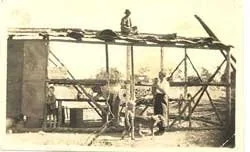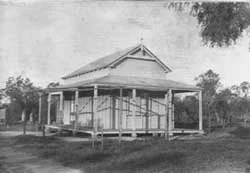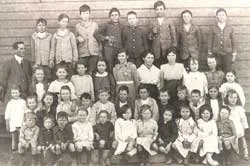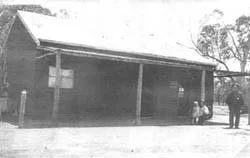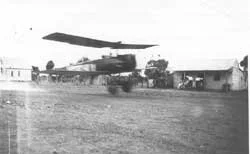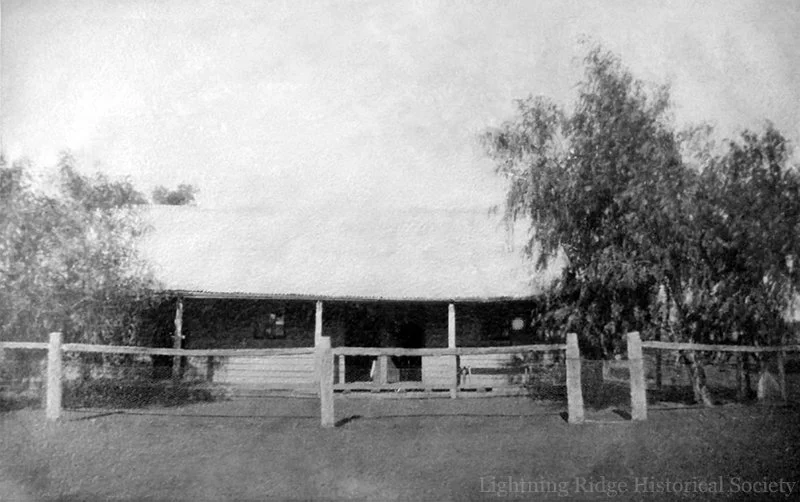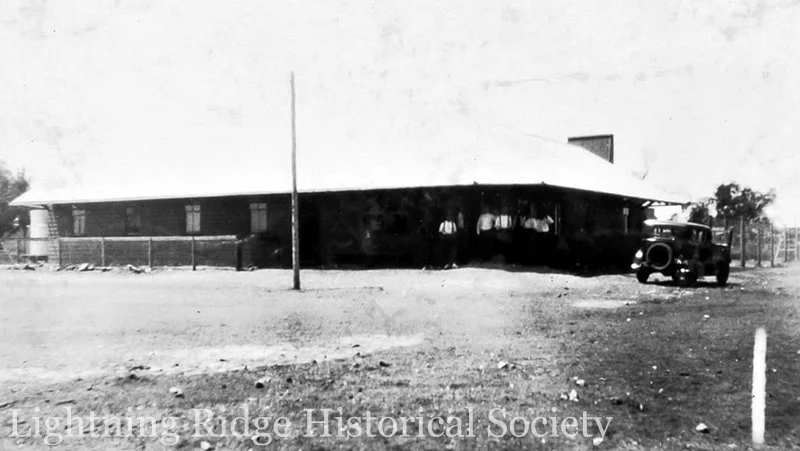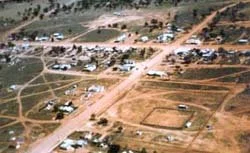Lightning Ridge History Timeline
This timeline is adapted and updated from the original Lightning Ridge history timeline that was published on behalf of the LRHS by Wolfgang Johannson in 1997, updated through to 2006.
The original history timeline as published on wj.com.au is preserved here in PDF format:
1900-1910, 1911-1920, 1920-1940, 1940-1970, 1970-1999, 2000 onwards
1873
Robert Moore, manager of the Muggarie run (now Angledool Station) finds surface opal on the southern part of the property. Opal specimens he sends to Sydney are returned as valueless, “worth 70 shillings per ton as road metal”.
1880
Some time prior to 1880, a farmer, his dog and 600 sheep are killed in a lightning strike on an ironstone ridge. The area is informally known as “Lightning Ridge” from here on, although the name would not be officially gazetted until 1963. Lightning Ridge Tank is sunk, located north of The Ridge on the traveling stock route (now the Castlereagh Highway).
1880-1900
Young boys Granville and Aubrey Spencer collect rounded gravels on the Nebea Ridges. They take then home to Cuttabunda Station across the Coocoran Lake, and do not learn until many years later that one of their gravel pieces is a black opal.
Surface opal is found by Mrs. Ann Ryan at Nebea.
1901
Surface opal is also found by Florence Murray and her young son, and by Jack Murray while he is setting rabbit traps. According to Mick Canfell via Frank Leechman, Jack got fired from his job for digging up the land rather than looking after it. Jack Murray is the first opal miner at Lightning Ridge, as per The Opal Book by Frank Leechman, 1961. Charlie Gibson prospects for opal on the Nebea Ridges.
Charlie Nettleton at his camp on the Three Mile.
1902
Charles Waterhouse “Charlie” Nettleton, a professional prospector with experience on the goldfields and with opal mining at White Cliffs arrives in the area and after meeting Ann Ryan at Angledool Town and seeing the opal she had collected, begins prospecting for opal.
1903
In March, Joe Beckett of Weetalibah Hotel, northend of the Walgett to Angledool road, and a syndicate of businessmen sponsor Charlie Nettleton to sink a shaft at McDonald's Six Mile, then on Angledool Station. Nettleton's Shaft proved to be a duffer, the syndicate wound up in June.
In June, the discovery of opal at Lightning Ridge is widely publicised in Australian newspapers.
Nettleton moved over to mine on Dunumbral Run near Jack Murray. Murray and Nettleton teamed up. In October, a parcel of black opal is taken to White Cliffs, where the market was based on light opal. This unusual nodular dark opal brought but a pittance from E F “Ted” Murphy, who was willing to take the risk, promising a supplement to follow with the approval of his principal, T. C. “Tullie” Wollaston in Adelaide. Wollaston is credited for developing the world market for black opal. The first mineral lease applied for in Walgett was 22 1/2 acres near Angledool village.
The Department of Mines makes its first mention of Lightning Ridge (Wallangulla) in its 1903 Annual Report:
“In the parish of Wallangulla, in the Walgett Division, prospecting for opal has also been carried out, but with apparently indifferent results.”
1904
The Annual Report of the Department of Mines records 26 miners on the field. Some early miners on the field were Jack Murray, Watty Heness, Ted Bishop, Canfell Brothers - Tom, Mick, and Jim, Charlie Nettleton, Charlie Gibson, Jack & Joe Wolstenholme, Charles Middleton, Dan O’Connor, Albert Holley, Peter Ferguson, Bob Buckley, Tommy Lewis.
1905
Ted Bishop finds two 19-oz pieces of opal during the first opal rush on Sim’s Hill, earning him the name “The Opal King”. He took his parcel to Sydney, prompted by a suspicious sale of one big stone in Angledool village. The Western Lands Minister of Mines was amazed at the good quality, in view of former information. Bishop sold his other big opal in Adelaide and made up his losses! The Mines Department reports 200 miners on the field early in the year, down to 75 in later months.
1906
Wallangulla settlement began forming near the Wallangilla Tank, the closest waterhole to the opal fields on the Dunumbral Run. Tenders were called for the sinking of a government tank for the fluctuating community as the farmers weren't cooperative with letting miners use their tanks. Hammond Hill at the Grawin discovered. The first Council of Walgett Shire formed. 100 men steadily on the field, up to 300 in the shearing off-season.
Earliest settlement, Wallangulla.
Smith’s Coach & Mail, 1906.
1907
New Town and the Cemetery were surveyed on land least likely to be opal bearing. Hence Wallangulla, where the school and post office had already opened, became known as Old Town. Tanksinker Fred Dowdle was working. E. F. “Ted” Murphy relocated from White Cliffs to become a resident opal buyer. 125 men on the field.
1908
Nettleton or Three-Mile Flat settlement sprang up in a gully just three miles west of Sim’s Hill, when a new rush broke out nearby, on the same long ridge. The Government Tank wasn’t completed, but it soon rained and filled. The Great Opal Robbery caused a stir. A local was convicted, based on the witness Ernie Smith, mail contractor. The Dominick Brothers, Albert and Jack, cycled from White Cliffs. Charlie Dunstan found a huge opal, Dunstan’s Stone or the Queen of the Earth, at Angledool diggings. The railhead was completed to Walgett. Miners averaging 350 men on the field.
Second settlement on the Three Mile Flat, 1908.
Lunatic Hill looking toward the Nettleton settlement, 1908.
Noodlers, 1908.
1909
In its heyday, probably 1200 people, mostly single men, lived on the Three Mile, an independent community to Old Town. Ion Idriess, miner and well known author, describes the situation in his Lightning Ridge: The Land of Black Opals, published 1940. The first accommodation, the Imperial Hotel, opened December 1909 in the New Town. The Bruce family arrived on the opal fields from Cobar, as did Pappa and Kitty Francis. Pappa, as well as Ernie Sherman, both White Cliffs opal buyers, relocated as production at White Cliffs fell. Mrs. A.B.J. "Kitty" Francis was the only lady opal buyer, as reported in the Walgett Spectator. The New South Wales Governor, Sir Harry Rawson, and his daughter visited Walgett and Lightning Ridge. The Kite Brothers from Temora, came north shearing, later settling permanently at the Nine Mile. The Department of Mines reports 500-800 active miners on the fields.
Brady’s house, 1910.
Nine Mile boundary store, 1909.
Aussie adventurer Ion Idriess, 1910.
1910
Population on the Wallangulla opal fields was larger than Walgett. A call by the miners for permanent water, a bore, to be sunk, fell on deaf ears. The first Billiard room opened across from the Hotel in Morilla Street. A post office agency was established at the Three Mile Flat, and the first New Town post office opened in November, in Morilla Street. The first baby girl born in the main street was christened Morilla "Milly" Canfell, by her father Mick. A tender went out for a school at New Town. Dances were held in Martin's Hall.
Store and police station, 1910.
The opal fields, 1910.
1911
Walgett Spectator reports the rumour: "...the ridge near Kookran Lake [sic] carrying good opal..." in reference to the Nine Mile. There is continued push for a bore by local Member, A. Black. The first census is held. The telegraph line is laid to New Town. The inaugural Race Meeting in September. A schoolmaster is appointed at Three Mile Flat.
1912
The government called for relocation of residents and businesses from the Nettleton settlement into the New Town. No further commercial leases were granted at the field settlements. Tom Urwin and Ronald McDonald built a school in New Town for the consolidation. Businesses began relocating. St. George's Anglican Church was built. Regan's Store specialising in cold drinks and treats was operating (next to the Black Opal Motel today).
1913
The Cottage Hospital formation committee chose three potential sites. Mandy Khan, formerly an Old Town shopkeeper, opened a branch to his Cumborah shop in Morilla Street (Bluey's Motel today). 280 men on the field in the Mines Department’s report.
1914
The Bush Nurse Association was established and the first nurse arrived and lived at the Hotel. World War I drew miners into service. The second Post Office is built by Tom Urwin in Morilla Street (demolished 1992).
Cottage Hospital, built 1915.
1915
The Cottage Hospital had been built with volunteer labour as directed by Urwin and McDonald (relocated to behind Graham Brothers’ cottage in Morilla Street 1999). Tom Urwin built a general store for Charles Nyghyah, formerly a hawker, then shopkeeper at Cumborah. Alongside, he built the first police station (the Bruce house today) across from the police paddock. Tom Urwin and Snowy Brown mined Empress of Australia (dropped and broken), Black Prince, Flamingo and Pride of Australia at Telephone Line. (In 1920, Ernie Sherman paid 2000 pounds for these stones, the highest price ever paid for four black opals!) Reeves General Store operated beside the Imperial Hotel, previously Dick Howe's bakery.
Lightning Ridge class of 1916.
1916
It was quiet during World War I on the opal fields. Cooper's Cottage (today) built by “Long Ben” Buren. Fred Bodel's hut on Three Mile Flat was built by German Brothers. The Flame Queen was mined on Bald Hill not far from Dunstan's Angledool diggings.
1918
Tom Urwin took over Nyghyah's general store as Urwin's Store, next to the police station. Urwin and McDonald built the hall across from the Imperial (where the Black Opal Motel is today). George Beckett, eldest son of Joe, fell in World War I. The Mines Department reports 200 miners on the field, and a population of 340.
1920
Dungalear's Gooraway Hotel on the Walgett road closed. Jack Dominick took up Lorne Station. Jack Boules found the Butterfly stone, the field where it was found is then named the Butterfly diggings and a new rush ensues. Dick Huggard (Kitty Francis' brother) built a second billiard room on the northern side of Morilla Street. Richard’s Hill at the Grawin was discovered. Mrs. Wilby Wilby was strangled at the Grawin Creek Inn, which had been delicensed for some years. No one was convicted.
The opal fields, 1920s.
The second post office, 1920s.
Billiard room, 1920s.
Plane landing in Morilla Street, 1921.
1921-1925
Albert Dominick became postmaster. There were three telephone subscribers. Bert Brown and his large family came to town. The men were fencing and ringbarking contractors rather than miners, initially. Fighter pilot Captain Wilson landed his plane in Morilla Street, and spent the afternoon offering joyrides.
Weetalibah Hotel.
1926-1928
The delicensed Weetalibah Hotel burned down, Constable George Cox Sr. inspecting the matter. Regan's Store relocated, even offering a small library courtesy of Dymocks! The Grawin Queen was found on the Grawin fields to the southwest, causing a sensation. The little community of the Grawin came the closest ever to being declared a village. The Sunset Queen, another large stone found at the Grawin, was broken into chips but was suspected to have been 9-10 oz., a massive opal. Pandora, also enormous, is found on the Angledool field. Light of the World from the Grawin was even larger than Pandora.
1927
The Imperial Hotel burned down on 18 May 1927. The publican was John Francis Nicholas, also known as “Hellfire Jack”, so-called as three pubs he had managed had mysteriously gone up in flames…
The rebuilt Imperial Hotel, 1928.
1928
The Imperial Hotel is rebuilt.
1929
A petition is lodged to reserve parklands (where the caravan park, sports complex and pool are today).
1930s
The government paid a shilling per foot to sink shafts during the Depression. The Bruces operated a general store in Morilla Street, where St. Vincent de Paul’s is today. They delivered on the field.
1932
Third post office built by Jim Alderslade (later Dawson’s Store, Maude’s Cafe, Outback Kitchen). Ray Hinds was postmaster. Spicer's or Graham Bros Cottage built by Bert Spicer when he struck opal with Laurie Hart, hence Hart’s & Spicer’s field of today.
The “leaning church” after a strong wind in 1933.
1933
A small cyclone blew The Anglican Church into a leaning position. It was propped up for a time: "Well supported Church in Lightning Ridge" headlined one Sydney article! New South Wales Governor Lord and Lady Game visit the Ridge. Five telephone subscribers.
1937
The second St. George's Anglican Church is built by Roy Allport, Jim Denis and Jack Boules. It replaces the original structure, condemned from storm damage. Bert Spicer sold his cottage to the Graham Brothers. Jack & Mary Francis married and took over the third post office and shop across from the Imperial Hotel. Mick Canfell returned and bought the old second post office from Albert Dominick, continuing to operate the general store within. The butcher’s stand that was added on the east end of the building in 1934 was leased out for about ten years. Both buildings were demolished in 1992.
Puddling, 1949.
1940s
World War II drew miners into service and the opal fields were quiet. The police station closed in 1944. The Cottage Hospital struggled to keep going on community funds. The school dwindled to fifty children. Bert Cooper and family arrived 1943. Artie Dawson moved in from Llanillo Station about 1946, and he took over Reeves Store, next to the Imperial Hotel. He delivered groceries on the field. Les Wharton took over the third post office and general store.
1950s
Bob Molyneux returned from Coober Pedy with his family. Lightning Ridge had its first full-time telephone service. Big floods! Orm Long developed the first dry rumbler. The Mud Hut in Morilla Street was built by Jack Leechman, son of author Frank. Harold Hodges came to the Ridge, bringing the first tram carriages for the Tram-O-Tel. The old hall (where the Black Opal Motel stands) blew down in a mini-cyclone. Dick Brown's Cafe in Opal Street opened late in the decade.
Aerial view of Lightning Ridge, 1960s.
1960s
The Tree of Knowledge, at the main intersection, was pulled down. Dawsons moved across the street into the third post office and general store. A syndicate of graziers sank Llanillo Bore No. 2, providing water for what are today's Bore Baths. The police station reopened. Roger Climpson came to town, filming the pilot for a television documentary series. The airstrip was surveyed, not to be surfaced for another thirty years. Electricity arrived in June of 1962, Sir John Northcott, Governor of New South Wales, visited to celebrate. The Bowling Club started in 1963. The Imperial Hotel was renamed the Diggers Rest in 1963-64. The first motel complex, Harold Hodges’ Tram-O-Tel, in operation. Eric Catterall developed the automatic hoist, significantly changing opal mining processes. The sinking of bores allowed access to permanent water, which allowed miners to use water for “puddling”, a method of washing dirt. The Walk-In Mine opened. Tex Moeckel's Bottle House is completed in 1967. Governor General Lord Casey and Lady Casey visited Walgett Shire and Lightning Ridge. The Lightning Flash Newspaper began in late 1969. The Black Opal Motel opens in December of 1969.
Eureka March, 1974. Lightning Ridge Historical Society.
1970s
1970 - April, the first Anzac Day march occurs at Lightning Ridge. The Lightning Ridge Tourist Centre opens. The Potch Point Park Trust is formed to maintain the small park on the corner of Potch and Gem Streets. June, the new miner’s puddling tank opens. July, the New Co-Op Store and service station opens.
1972 - the beginnings of an ambulance service at Lightning Ridge. The first banking service is opened at Lightning Ridge, the Bank of New South Wales (now Westpac). Harold Hodges and John Molyneux donate 20c for each of 190 children from Lightning Ridge Primary School to open an account. October, one of the earliest mentions in the Lightning Flash Newspaper of the intent to preserve Charlie Nettleton’s first mine shaft for posterity.
1974 - law reform repeals the Miner’s Right, replacing it with a miner’s license, further permissions are imposed on the miner to prospect on farming land. About 900 miners march in protest behind a Eureka flag and hand-made protest banner.
1976 - The Pistol club was formed by 20 keen locals. The club house was corrugated iron and the range had manually turned targets timed with a stopwatch. In 1977 the first Great Goat Race is organised by Peter Prentice and is held during the Easter celebrations.
1980s
The Lions Club is chartered in 1983. Halley’s Comet is found on the Three Mile in 1986 by the Lunatic Hill Mining Syndicate, the Nobby weighed in at 1982.5 carats.
1990s
A booming decade for the opal industry at Lightning Ridge. The Lightning Ridge Olympic Swimming Pool opens in December 1990. Outback Air Show organised by Barry Barnes is held in September 1991. In the same year, a salute to Frederick York Wolseley dinner is held. Lightning Ridge Primary School transitions to Lightning Ridge Central School, offering high school education without the need to travel to Walgett. 100 years of British Motoring is celebrated at Lightning Ridge in 1995. In 1998, St. George’s Anglican Church is relocated to Sherman’s Way as St. George's Serbian Orthodox Church. 1999, the Bush Nurse Association (BNA) cottage hospital is relocated to the yard of the Lightning Ridge Historical Society museum in Morilla Street.
The Diggers Rest hotel burns, 2006. Photograph from the Black Opal Advocate newspaper.
2000s
The Lions Club wraps up after 18 Years in June 2001. In 2003, Outback Cafe - formerly Maude’s Take Away and historically Dawson’s Store burns to the ground. In 2006 The Diggers’ Rest Hotel burns down for the final time, and is never rebuilt. In 2008, the Australian Opal Centre’s showroom in Morilla Street is opened by Her Excellency Dame Marie Bashir, Governor of New South Wales and Acting Governor General of Australia, visiting Lightning Ridge with husband Sir Nicholas Shehadie.
2010s
In 2010 the final Great Goat Race runs. 2014 - The Spirit of Lightning Ridge statue honouring Charlie Nettleton is erected outside the Lightning Ridge Historical Society Museum in Morilla Street.


